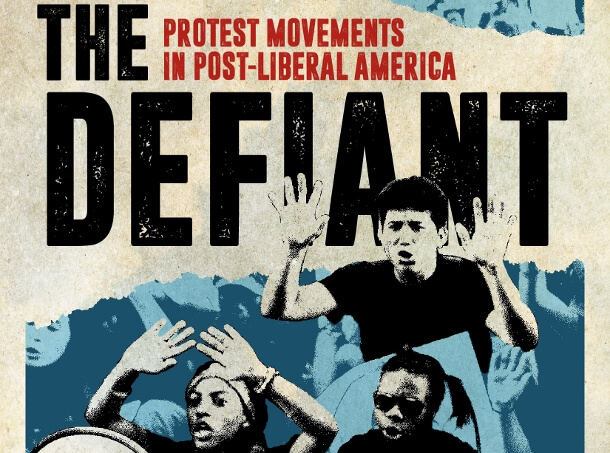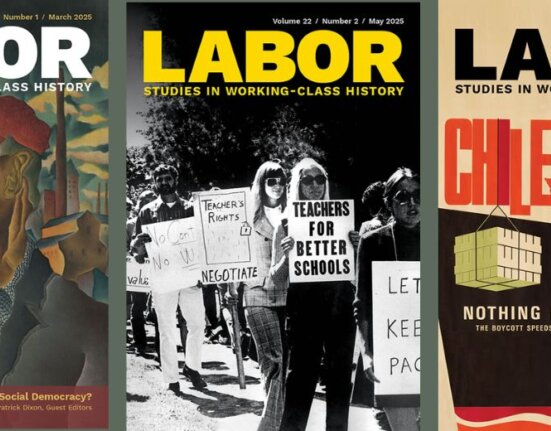Joseph Walzer recently interviewed Dawson Barrett on his new book, The Defiant: Protest Movements in Post-Liberal America, a book that looks at the period from 1980 to the present through the lens of dissent—through the picket lines, protest marches, and sit-ins that are often overlooked.
Your book is a history of protest movements in “Post-Liberal America.” Could you talk a bit about how you found “post-liberal” to be a useful framework?
I start what I am calling the “Post-Liberal” period with the election of Ronald Reagan—though it was, as with most shifts in history, a gradual transition. For my purposes, the key change is from a mainstream bipartisan consensus around New Deal liberalism (policies that soften some of capitalism’s harshest edges and encourage the creation of a middle class of consumers) to a bipartisan consensus around neoliberalism (a word I detest, but in the simplest version, essentially just tax cuts for the rich, austerity cuts for the middle and working classes, de-regulation of industry, and the transfer of tax dollars to corporations through privatization).
The predictable punchline of the neoliberal joke is that it has made the rich much, much richer at everyone else’s expense – a four-decade transfer of wealth on an almost unimaginably large scale. Today, our country is so lopsided (the richest 1% now have 40% of US wealth) that the deeply flawed “Liberal Era” of the 1930s to 1970s looks much more attractive than it should.
That’s part of the story, but since I study protest movements, my interest in this period is really rooted in trying to understand the shifting political terrain – why protest strategies that worked in, say, the 1930s or 1960s did not work in the 1980s or 1990s. Essentially, I am trying to get at how and why the vulnerabilities of the people at the top have changed.
I found your book very readable to a variety of audiences. Could you talk about who you imagined to be your audience as you wrote The Defiant, and what you hoped they would come away with?
Yes, I wrote it deliberately to be accessible, and I tried to use essentially the same language that I use in the classroom. My goal from the start was to write the book that would have helped 19-year-old me get up to speed and think about power and protest less naively – though, on the whole, I actually think young people today are more with it than I was.
In my experience, these are stories and concepts that resonate with students and allow them to “connect the dots.” So, I hope that the book (or even just a chapter from it – they mostly stand up on their own) makes its way into college courses: post-1945 US, social movements, democracy, and others. That is why it exists. To that end, there may not be much in it to surprise a historian, but it should be the type of book that helps instructors build lectures—one of my favorite genres.
You bookend your text with two key moments in recent memory—the 2011 Wisconsin capitol occupation and the “Muslim Ban” protests at Kennedy International Airport (and airports throughout the US) in 2017. What importance do these seemingly disconnected events have to the historical conflict you illuminate throughout the book?
There are several connections. Perhaps chief among them is the demonization of marginalized groups—school teachers and immigrants, in this case—for economic decisions that they did not make, by the people who actually did. But I also use those two cases deliberately because I think they reflect us at our best, leaving our homes in droves to stick up for our neighbors, staring down incoming regimes and shouting, “Hell no you don’t…at least not without a fight!”
Plenty of the book covers policy decisions and atrocities, but it is also, openly, a book about a struggle. We live in a pretty bleak period of history. I think it is important to highlight inspiring moments, both in the past and in the history that is being made right now, whether it’s Bree Newsome taking down the Confederate flag at the South Carolina statehouse a few years ago or the nationwide high school walkouts that swept the country earlier this year. Those are the kinds of stories that I think matter.
How has post-liberal protest represented a “movement of movements,” as you describe?
Though I use it, that phrase isn’t always super helpful. I definitely do think that it makes sense to talk about various protest waves, and even separate movements, as part of the same thing – as one big team, even if the players don’t always like each other. For one thing, this is very often true across time. For example, many of the same people who helped organize the Seattle WTO protests in 1999 also then contributed to the Iraq War protests from 2002 on, and to Occupy Wall Street the following decade.
What I am also trying to articulate, though, is that these are all expressions of protest against the same thing – crass greed that is destroying people’s lives and undercutting democracy. In short, these are movements against neoliberalism.
We can see this even in just the last year, in the high school walkouts, strikes by teachers and prisoners, and protests against the Trump administration’s immigration policies. Of course, issues like student safety, xenophobic cruelty, and basic human rights are in play here, but each of these protest waves also confronted at least one of the neoliberal planks: privatization (prisons, detention facilities, charter schools), de-regulation (prisons, gun manufacturers), or austerity cuts (public education budgets). They are presented as separate things, but they have much in common. That doesn’t mean that every striking teacher agrees with the high schoolers, or that every striking prisoner opposes US immigration policy. They are fighting against the same opponents, though, and the other team is driven by many billion dollars in profit motives.
Your work on youth protest movements in the United States has recently received a lot of attention in the wake of the #NeverAgain Movement, including a piece in Teen Vogue. What roles do you see youth movements playing in the resistance to neoliberalism and neofascism?
Yeah, it was a little funny to be kind of popular for a minute, but not because of the book that was about to come out!
There are youth in The Defiant, but they are not a deliberate focus. What I was getting at in the Teen Vogue piece and in my book for high schoolers, Teenage Rebels, is that teens have been on the front lines of essentially every movement for change in this country’s history. They haven’t always been right, but across time, I would take their record over, say, people in their sixties. In the conflict that essentially pits students who don’t want to be murdered against people who want to collect machine guns, for example, I think history will look much more fondly on Emma González than on Wayne LaPierre.
For obvious reasons, the gun violence issue has gotten the most attention, but just in the last couple of years, high schoolers also participated in the Women’s March, developed Sanctuary policies for their schools, played a pivotal role at Standing Rock, and knelt before football games. They’re doing their job. We need to do ours.







